La Salle Military Academy
| La Salle Military Academy | |
|---|---|
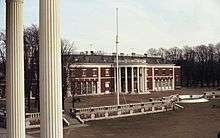 The Esplanade, Bourne Mansion and Parade Field as seen from St. Joseph's Hall | |
| Address | |
|
500 Montauk Highway Oakdale, New York, Suffolk County 11769 United States | |
| Information | |
| Type | Private, Roman Catholic school (Lasallian,) Military, Day & Boarding |
| Religious affiliation(s) |
Roman Catholic (Lasallians) |
| Established | 1883 (as Westchester Institute) |
| Closed | 2001 |
| Grades | PK–12 |
| Color(s) |
Blue (Loyalty) White (Honor) |
| Athletics conference | CHSAA |
| Team name | "Kaydets;" later "Blue Knights" |
| Newspaper | The Marksman |
| Yearbook | The Sabre |
The La Salle Military Academy was a Catholic school with middle school/junior high school and high school divisions located in Oakdale, New York. It closed in 2001, and the school's extensive campus is now owned by St. John's University located in nearby Jamaica Queens.
School history
The school was founded by the Institute of the Brothers of the Christian Schools, or "Christian Brothers" (sometimes called the "De La Salle Brothers," having been founded by St. Jean-Baptiste de la Salle in France in the 17th century as an organization of Catholic men under vows dedicated to teaching; the term "De La Salle" brothers distinguishes them from the Irish Congregation of Christian Brothers and other, similarly named and purposed groups).
The school was actually founded in Westchester, New York in 1883 as Westchester Institute. Soon thereafter, the school relocated to Clason Point in the Bronx, New York, and was renamed Clason Point Military Academy. In 1926, the school purchased the estate of Frederick Gilbert Bourne, of the Singer sewing machine company, which featured a 110-room mansion, Indian Neck Hall, overlooking Great South Bay, Long Island.
The school had extensive boarding facilities and attracted many sons of the wealthiest Catholic families in the northeastern United States. It also attracted a strong international contingent, particularly from Latin America. For many years LSMA was considered one of the top preparatory schools on the East Coast. It was accredited by the Middle States Association of Colleges and Schools. Its academics were held in the highest regard and although LSMA did not require its students to take Regents exams, they never found this to be a problem. LSMA's reputation was such that its grads were consistently admitted to the best colleges. Graduating classes were often 100% college-bound.
Another academic benefit of not being a Regents program was that the faculty were not bound by a rigid curriculum, which widened the school's latitudes when it came to classes. This benefited the day-to-day education that took place there. For example, in English classes students would often read books that would never have been permitted in a Public School setting (e.g. Kurt Vonnegut, Evelyn Waugh, Bernard Malamud). Honors-track students were often able to take college-level courses (curriculum-wise). LSMA offered some very advanced Math and History classes, as well as Marine Biology.
Academic and JROTC programs
The Christian Brothers administered the academic program, while the military program was run by the United States Army in close coordination with the Christian Brothers. La Salle was consistently rated in the top ten military high schools in the country. As a "Junior ROTC Honor School with Distinction," the school could actually make nominations to the service academies. The school maintained this status until it closed its doors in 2001. Another benefit of this status was that the Army assigned active duty personnel to conduct Military training. This was led by a command-rank officer (usually a Colonel or a Major), who served as the school's SAI (Senior Army Instructor). The rest of the team was made up of NCO's (non-commissioned officers, i.e. sergeants). For many of these Army personnel, LSMA was their last stop before retirement.
Campus
Perhaps the most distinguishing feature of LSMA was its magnificent campus. In the Sixties and Seventies the campus was 200-plus acres, though later classes may remember the campus being smaller. Older alumni may remember that the golf course adjacent to the campus had once actually been part of the campus in the 1920s and 1930s.
Bourne Mansion

The Bourne Mansion housed the school's Admissions and Finance offices. The old servants' quarters on the upper floors housed the Christian Brothers on the Second Floor, and the Third Floor was converted to student housing. It also had sitting rooms for students to visit with parents and sometimes girlfriends as well. The ornate old ballroom of the mansion was converted into the school chapel during the La Salle years. In the summer of 1976, Br. Roger Chingas led a group of students in dismantling an Opus One pipe organ which was about to be destroyed in a church in Albany NY. Br Roger then oversaw the restoration of the pipe organ piece by piece in the Chapel where it remains today. For a period of time, the chapel was converted into a catering facility by the Lessings. Today it has been reverted to its original purpose.
There was an abundance of school lore about the old mansion. For instance, there was a long-abandoned swimming pool in the basement. School legend had it that it had been shut down after Commodore Bourne's son had drowned in it. According to legend, Commodore Bourne was distraught over his son's drowning and sold the mansion to the Christian Brothers for $1 with the agreement that his son's portrait would never be moved from the mansion's main parlor room, and the swimming pool would never be used again. Other school legends pertained to secret passages inside the Mansion. Legend also had it that there was a tunnel that ran from the "Esplanade," a raised brick veranda on the south side of the Mansion, to the Horse Stables, 1/2 mile East of the mansion.
The Esplanade
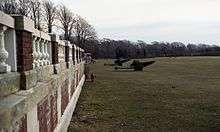
The Esplanade provided a scenic view of the vast Parade Field and the Great South Bay beyond. Cadet parades of the several-hundred-strong Cadet Corps were reviewed from this vantage point. Sometimes the cadets wore "Full Dress" uniforms with brass buttons and breastplates, sashes, gold brocade, and medals. During much of the school's existence, LSMA uniforms were made and tailored by Brooks Brothers in Manhattan.
The Boathouse
Another vestige of the old estate was the Boat House, which was alongside a boat basin that emptied into the Great South Bay. During the La Salle years it housed the school infirmary. In addition, it was retrofitted with seats and at stage and it served as the school auditorium as well as the theater house where plays and movies where shown to students and parents alike. In the 1980s Centennial Hall and it because the center for the arts. From at least 1990 to 98 the boat house was converted to a game hall with pool tables, TV's, pinball machines and arcade games. It also housed a small kitchen where students could order and pay for meals not part of the school lunch program. Later it was damaged by storms and rendered unusable. It is currently boarded up and abandoned.
St. Joseph's Hall & Senior Steps
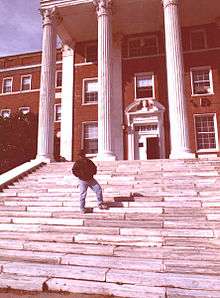
The main cadet residence hall at La Salle was St. Joseph's Hall, a massive four-story building that was taller than anything else for miles. It was one of the biggest structures along the Great South Bay shoreline and remains so to this day. The basement floor contained, classrooms, along with the athletic locker rooms, a barber and the gymnasium in an adjacent structure. Another important area of the basement was the rifle racks of the various companies. Each company was assigned its own rifle rack. As an ROTC Honor School, the U.S. Military provided rifles for drilling purposes (no firing pins) and each cadet was issued a rifle. The Military staff took security for these weapons very seriously and the FBI was summoned if any were found missing, although that rarely happened.
In addition to being the main classroom floor, the Second Floor of St. Joseph's Hall contained Administrative offices such as the Dean of Studies, the Commandant, the Guidance Office, etc. The east side of the building was distinguished by a massive white marble staircase. This staircase was commonly known amongst the cadets as the "Senior Steps" because school rules forbade underclassmen to stand or walk on them. Transgressions by underclassmen were punished by being forced to clean them with a mop or scrub brushes, depending on how strict the senior class felt like being. School legend had it that some violators were even made to scrub it with a toothbrush!
The third and fourth floors of St. Joseph's were residence areas for cadets. The Third Floor housed "A" and "B" Companies; the Fourth Floor housed "C" and "D" Companies. (A fifth Company, "E" Company, was housed in the residence area in the third floor of the Mansion.) It should be noted that there were no elevators in any of the LSMA buildings, so cadets would have to climb quite a few steps during the course of the day. The building also had an attic with a high ceiling which could have been made into additional space had the school been so inclined. As it was, it was used for storage.
Molloy Hall

The seniors were all housed in a building separate from the underclassmen called Molloy Hall. It leveraged some lovely features of the old estate such as a kayak house on the stream adjoining it and a rose trellis. The trellis has since rotted away, with only a single section and concrete footings remaining. Similarly, the kayak house disintegrated and only the concrete base remains. Seniors were housed two to a room, as opposed to between four, six and eight cadets to a room for underclassmen. If both roommates smoked, smoking was permitted in the room although LSMA later became a "non-smoking campus." Also, seniors were the only cadets who were permitted to have cars on campus and parking spaces behind Molloy Hall facilitated this.
Centennial Hall
Built during the 1980s, Centennial Hall became the school's main auditorium. It housed the LSMA music department, and was also home to outside performing groups. At one time it was even used to stage Oldies Rock and Roll shows. It currently houses "Kids for Kids Productions," a non-profit children's drama group.
"Pete's Island"
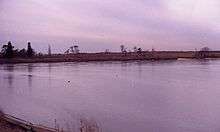
There is a large parcel of undeveloped salt marsh directly to the west of the boat basin, which can only be accessed over a single wood bridge. This open shore front area of about 100 acres is designated by the State as "Protected Wetlands Habitat." This means the land cannot be developed as long as it retains that status. The reference "Pete's Island" was for Brother Azarius Peter (Brother Pete,) who focused on grounds maintenance and sometimes dumped organic waste (leaves, branches, etc.) there with his truck. Cadets with too many demerits were required to work with Brother peter after school hours. Although a fascinating place to explore nature, Pete's Island was a designated "out of bounds" area for cadets. However, cadets did sometimes go there on field trips for their Marine Biology classes.
Cadet life
As in many military institutions, life at LSMA was very structured and rigorous, with a cadet's days very tightly scheduled. A typical day began at 6:15AM with Reveille and hall formation when a head-count was performed and the "floor prefect" (a Brother aka "monk") would read the daily notices, followed by 1/2 hour for bathroom, dressing and bed making (the bed had to be made with "hospital corners" and have a flipped coin bounce when striking the blanket). Then at 6:45AM formation on Company Street, the concrete street on the East side of St. Joseph's Hall. The cadets marched off to breakfast in their daily uniforms. After breakfast, inspection was held. Cadets were in uniform and with their issued rifle, an M-1, clean-shaven (for those old enough to shave);, shoes and brass shined. Any deficiency gained the cadet "demerits," and an accumulation of twenty or more meant the cadet had to "march post duty" on Saturday morning and lose any pre-planned chance to go home or visit to another cadet's home (note: all visits [even home] required written permission from the cadets parent(s); a cadet going to another cadet's home required written permission from both sets of parent(s)). After inspection, the cadets attended classes much the same as in any school. La Salle justly had a reputation as a top-notch school academically. Many cadets reported that their first and second years of college were a rehash of the classes they had at LSMA. At various times the school offered advanced college-level classes to students as young as tenth grade. Honors students even studied Calculus and Marine Biology. The LSMA campus, on the shore of the Great South Bay and adjacent to protected marshlands, provided an ideal environment for such studies.
After classes ended the cadets formed on the parade field for drill. Cadets drilled as squads, platoons and companies at various times. Competitions were held, with awards given by the Military Staff to the best drillers. Another very competitive area was Manual of Arms, with competitions among the Cadet Corps at large as well as the elite La Salle Rifles drill team.
After drill time, there was "free time," which for most cadets meant either interschool or intramural sports. There were Baseball, Football, Cross Country, Winter Track, Spring Track, Basketball and Soccer teams. Because LSMA was in the Catholic league with Diocesan high schools ten times its size, it was often tough to be competitive. However, LSMA did prevail for several championships. With so many Latin students, they often fielded a good Soccer team. Their Speech and Debate team was a perennial powerhouse as well. In addition, the academy had a fine shooting team.
After free time, the Cadets changed and there was an evening formation. The flag was taken down and the Cadet Corps marched off to dinner. After dinner, there was a little additional free time until Study Period - three hours where students had to sit at their desks (no bathroom break) and were expected to study their academics (floor monitors would see to this). Taps was at 10PM.
Plebe system
Adjusting to at a new school is difficult enough for most kids, but new entrants to La Salle faced their own unique set of challenges. They had to complete the "Plebe System," a rigorous program of training modeled after the one used at the U.S. Military Academy at West Point. The term was an abbreviation of the Latin word "Plebeian," which generally indicted a "common" person or one of lower class. Plebes were reminded on a daily basis that they were "The lowest form of life on Earth." They were badgered and quizzed by the upperclassmen, and usually there were a lot of pushups as well. The presumed purpose was twofold: to Administrative purpose of acclimating the new student to life at the Academy, and the deeper Military purpose of teaching the new cadet how to function in high-pressure situations.
All new cadets were required to graduate the Plebe System. Plebes were generally freshmen but sometimes were sophomores or even juniors. Herein are some of the requirements:
Plebe Knowledge - Information about the Academy was posted daily, which each plebe was expected to know. All upperclassmen had the right to quiz any plebe on the day's knowledge or that of any previous day, and exercised that right liberally. Plebe knowledge might include the names of the Battalion Staff, key members of the Faculty and Military Staff or factoids about the school's history such the year it was founded. Plebes were also expected to know the school song, "Hail Alma Mater Fair," and be able to sing it on demand. It's a pretty good bet that most LSMA graduates still can.
Running/Squaring Corners - Plebes were required to wear combat boots instead of shoes during the day. Whenever they were outdoors on campus, they were expected to run to wherever they were headed. LSMA having such an expansive campus, this could be tough on plebes who were not athletically inclined. A plebe who was not moving sufficiently fast was likely to have "RUN PLEBE!" shouted at him by upperclassmen. Plebes had to run on the walkways and were not allowed to walk on the grass. Furthermore, whenever the plebe had to make a turn they were expected to stop, make a proper right-face or left face, and continue on their way. This practice was known as "Squaring the Corners."
Bracing - Probably every plebe's least-favorite thing was having to "brace." Whenever standing in formation, plebes were required to "Military brace." This consisted of using one's neck to press the chin against the collarbone, producing pleats in the flesh under the chin. Obviously, some of the more corpulent plebes found this easier than others, but for most plebes bracing was quite literally a "pain in the neck." Even worse, the upperclassmen would shout things like, "CHINS! I WANNA SEE CHINS!"
Military brace has also caused Erb's palsy in Military School cadets. [1]
Graduation of the Freshman Class - Provided the Battalion Staff and the Military Staff were satisfied that sufficient progress by the incoming class, Plebes "graduated" to being freshmen (or whichever class they were entering) on Father's Day in October. As cited elsewhere, Father's Day fell after the end of the school year so LSMA celebrated it in October. This was the new students' first experience parading with the Cadet Corps and a "coming out" of sorts. Seniors, meanwhile, came forward to receive their senior pins.
Demerit System - Post Duty/"Hunyak" Duty
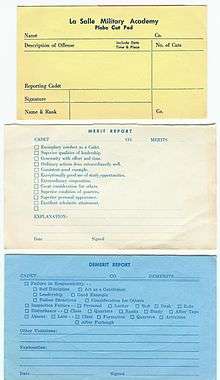
Cadets worked on a "Demerit System" in their daily activities in the JROTC program. Demerits were typically issues during personal and room inspections for deficiencies. Sometimes they were issued for failing to report for formations or lateness. Other times they were issued for insubordination, failing to follow orders or wisecracks. Accumulation of 20 or more demerits on a given week resulted in "Post Duty" which was not standing guard as was required in the regular Military. For LSMA cadets, "Post Duty" meant marching with a rifle on Company Street on a Saturday morning when most of the other cadets had either gone home for a special weekend furlough, or began the day of "free time". Other times in lieu of marching Post Duty, cadets were required to do "Hunyak Duty." (The term "Hunyak" was cadet slang for the groundskeepers.) This meant the offending cadet was made to do work maintaining the Academy grounds such as raking leaves, cleaning up litter, emptying trash bins, etc. Fortunately, an excess of demerits could be offset by the accumulation of "Merits," which were usually awarded for excellence in drill or inspections, or for doing favors for upperclassmen and sometimes Faculty members.
Athletics
Although La Salle was very competitive in the 1940s and '50s and even into the 1960s, by the 1970s it was at a very distinct disadvantage. With a student body of roughly 400 students it competed with diocesan and other religious order-sponsored schools which boasted over double the number of students. Still, LSMA managed to field some winning teams. In the 1961 CHSAA Indoor Championships at Madison Square Garden, senior Joseph Lynch, won the inaugural 2 mile run and set the national indoor record. The 1966 Varsity Football team was undefeated, and the 1970-71 Freshman Winter Track team won a league championship as well. In the 1970s La Salle fielded an excellent soccer team, largely manned by Latin students who grew up playing the game. The 1980 Boys Soccer team won the Suffolk County Class C Championship. LSMA Soccer Championship Team
Company Street
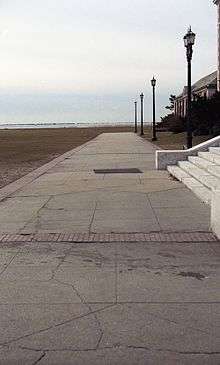
Company Street was the concrete road that adjoined the East side of St. Joseph's Hall. This was the center of cadet military life. All morning, mid-day (lunch) and evening formations took place on Company Street, as well as formations for afternoon drill. Daily personal inspections were also held on Company Street. During the winter, which could get pretty cold, the cadets would sometimes, but rarely, muster in the basement of St. Joseph's Hall. This was at the discretion of the cadet Battalion Commander and the Military staff.
During parades for guests, the Cadet Corps would muster on the West side of St. Joseph's, so they could be seen coming around the south end of the building. It made for a more impressive entrance when viewed from the Esplanade.
Cadet parades

The Cadet Corps had several regularly scheduled parades during the school year:
| Month | Day | Description |
|---|---|---|
| October | Father's Day | Since Father's Day fell after the school year ended, LSMA celebrated it in October. Seniors were given their Senior Pins by their fathers. It was also traditionally the end of the "Plebe" period for Freshmen. |
| April | I.G. Day | Every year the Inspector General's office of the regular army would send an inspection team to check the LSMA campus and cadets. This was required for the school the maintain its "JROTC Honor School with Distinction" status. The activities always included the Cadet Corps parading for the inspectors. As far as the Military Program was concerned, this was the biggest day of the year. As described earlier, with the Service Academy nominations and the Military personnel the Army provided in the balance, there was a lot at stake. |
| May | Mother's Day | The mothers of the cadets would present members of the Junior class with their senior rings. |
| May | Summer Drill Day | Generally this was the second-biggest day of the year. Cadets and Faculty invited their friends and relatives to come to this day of demonstrations by the cadet corps. The various companies competed for the Clason Point Trophy to the unit who scored the highest in points. There were military demonstrations, drill contests and military displays. The regular Army would lend vehicles like tanks and helicopters for viewing and sometimes riding by guests. The afternoon would end with the Cadet Corps "passing in review" (parading). |
| June | Graduation Day | The graduating class would lead the Cadet Corps for the final time. When the Corps was on the Parade Field the Captain Adjutant would order, "SENIORS FORWARD" and they would proceed to the graduation ceremony. The Junior class would the lead the remaining cadets in finishing the parade, in a ceremonial "passing of the torch." |
La Salle Rifles
The pride of LaSalle Military Academy was the La Salle Rifles trick drill team, which maintained a tradition of excellence throughout its entire existence. The team was always top-notch and was consistently competitive with older, college drill teams. They won three National Championships as well as multiple individual and small-group competitions, especially throughout the 1980s and 1990s decades. The team was founded by then-cadet Louis Dethomasis '57, who later became a Christian Brother and the school's Headmaster and later President. The LaSalle Rifles functioned as a special company (along with the Drum and Bugle Corps) and it was very competitive to join it. Only the very best drillers were picked for the 32-cadet team. The "First Sixteen" were the first-stringers who competed in the tournaments. The "Second Sixteen" was the developmental squad, composed of freshmen and sophomores. The team performed impressive maneuvers with their rifles, including throwing and catching rifles within ranks. A more hazardous variation of this - and one for which they were justly famous - was doing so with sharpened bayonets!
Changes in enrollment - LSMA to La Salle Center
In the mid-1990s, the school decided to begin admitting girls as well as non-military students. It changed its name from "La Salle Military Academy" to "La Salle Center." The JROTC Military was made optional, and so cadets attended classes side-by-side with non-military, "Prep" students. By the time the school closed, only a fraction of its students participated in the Military program. It also began extending its classes into the Middle School and later into the Elementary grades.
Distinguished alumni
La Salle was the school of numerous famous people, including Hollywood movie director John Frankenheimer, former New Hampshire Governor and White House Chief of Staff John H. Sununu, two Nicaraguan Presidents, Luis Somoza Debayle and his younger brother, the more notorious dictator Anastasio Somoza Debayle,[2] and former U.S. Congressman from New York John M. Murphy (1965 graduation speaker), in addition to Bill Donohue, the President of the Catholic League . It also had a large New York area mafia family patronage including sons of the Gambino family, the Lucchese family, as well as Alois Pfister Gonzalez, Alberto Baillères, Forbes 100, from Mexico.
See also
References
- ↑ TM Lain (April 1969). "The military brace syndrome. A report of sixteen cases of Erb's palsy occurring in military cadets.". The Journal of bone and joint surgery, American volume. 51 (3): 557–560. PMID 5781588.
- ↑ Horgan, James J. (1990). Pioneer College: The Centennial History of Saint Leo College, Saint Leo Abbey, and Holy Name Priory. Saint Leo College Press. p 464
External links
The official website for the La Salle Military Academy Alumni Association is www.lsmaalumni.org
Coordinates: 40°43′48″N 73°07′10″W / 40.73000°N 73.11944°W